| |
They will beat their swords into
plowshares and their spears into pruning hooks.
The Cold War ended, the Russians went home,
the vast majority of the US 7th Army went home as well. The Germans
stayed, it was their country and it was reunified. There was trouble
in Albania and the states of the former Yugoslavia; crafting a new
international reality is certainly never easy or inexpensive but the
evidence seemed beyond dispute ... we won. In Kuwait, we won again.
Nations of the former Soviet block, to
qualify for western economic aid, quickly began compliance with the
Treaty on Conventional Armed Forces programs. Poland found a new
industry as they consumed hundreds of thousands of cubic meters of
acetylene gas to render vast fleets of Soviet era tanks, fighting
vehicles and cannon from all across Europe into scrap. They cut and
they chopped and still the rail loads continued to arrive. So much
recycled steel hit the market in Europe, the per ton price dropped
below the costs required to render a tank into useable blocks.
Welcome to the new economy.
| |
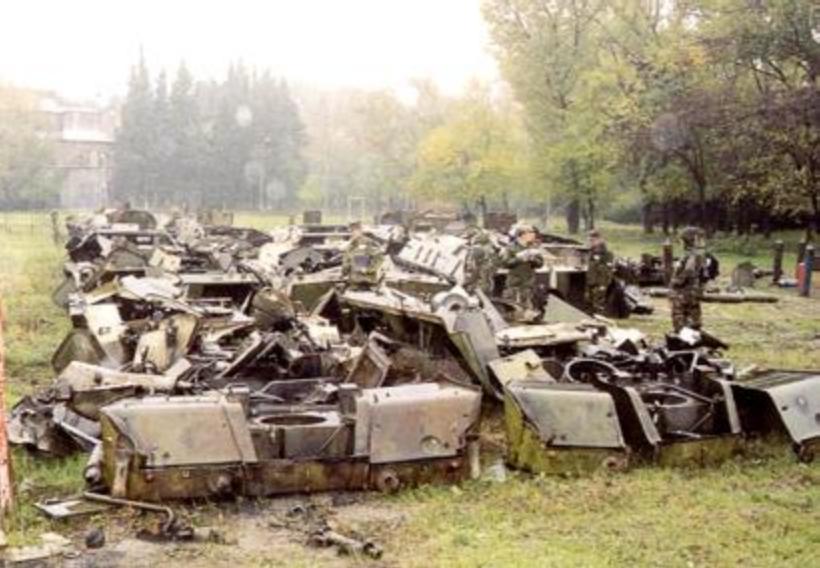 |
|
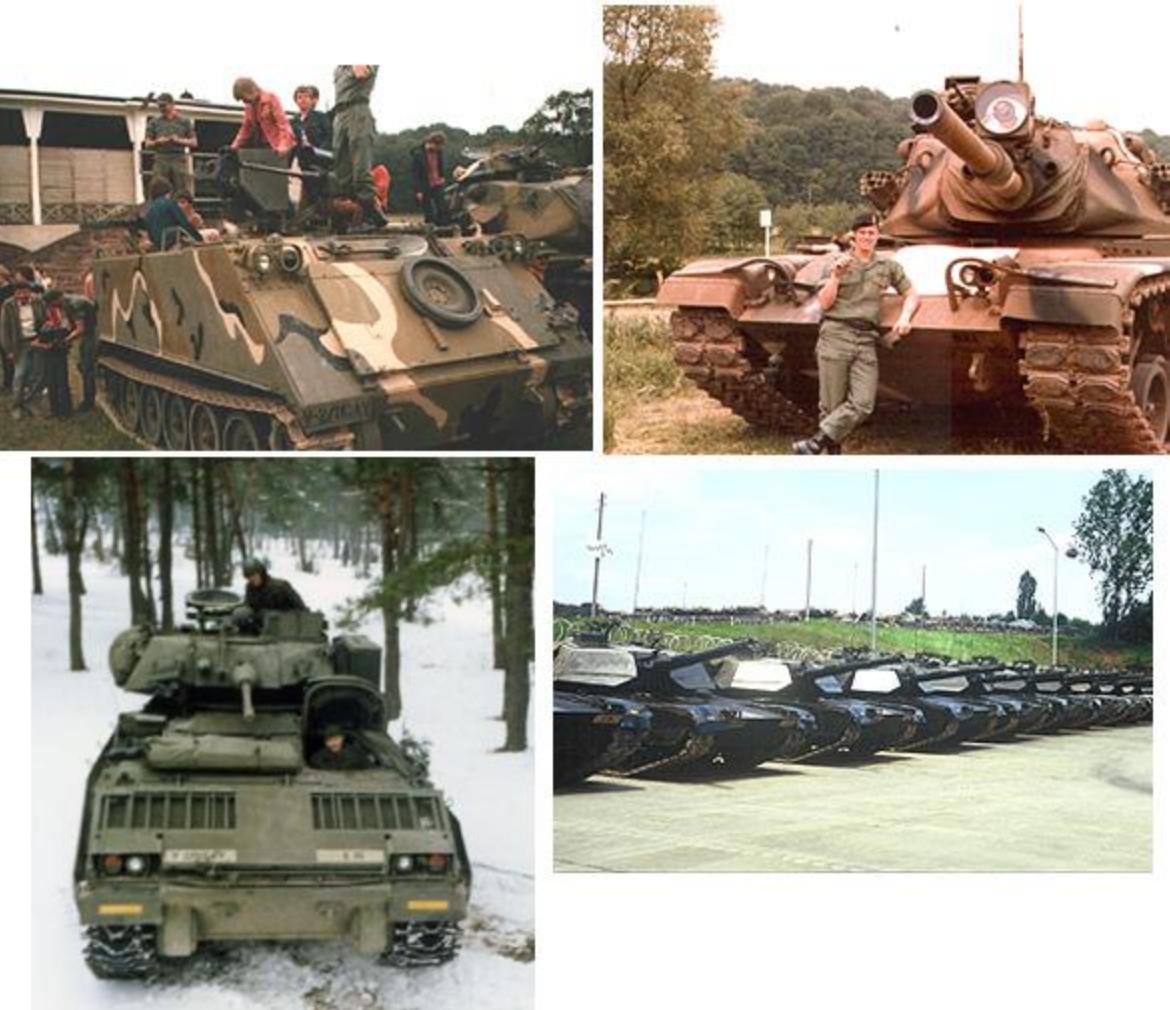 |
|
| |
Cut up Soviet armored fighting vehicles wait for shipment to the
smelter.
--Canadian Military Journal |
|
Two generations of Eaglehorse equipment in Germany.
--Stefanowicz / Frederecci |
|
Did you ever wonder where your old tank, PC,
fighting vehicle went or where it came from? Over at the Historical
Records Division of General Motors, they can, with a little luck and
about fifty bucks, produce the Build Sheet for that Trans Am in your
garage that you are trying to restore. In the sparse language of
business and manufacturing, the sheet details the date and time that
your project car first started down the assembly line, what options
were programmed, what was the paint code, it's all blocks on a form
filled with number and letter codes. With a little more luck, they
will produce a copy of the "pass through sheet" telling when your
car, brand new and shining for the first time in natural light,
emerged from the factory on day X, was assigned to lot Y for rail
and road delivery to dealership Z. Fun stuff. At least you know how
the story started. The record keeping for tanks is not nearly that
exact.
| |
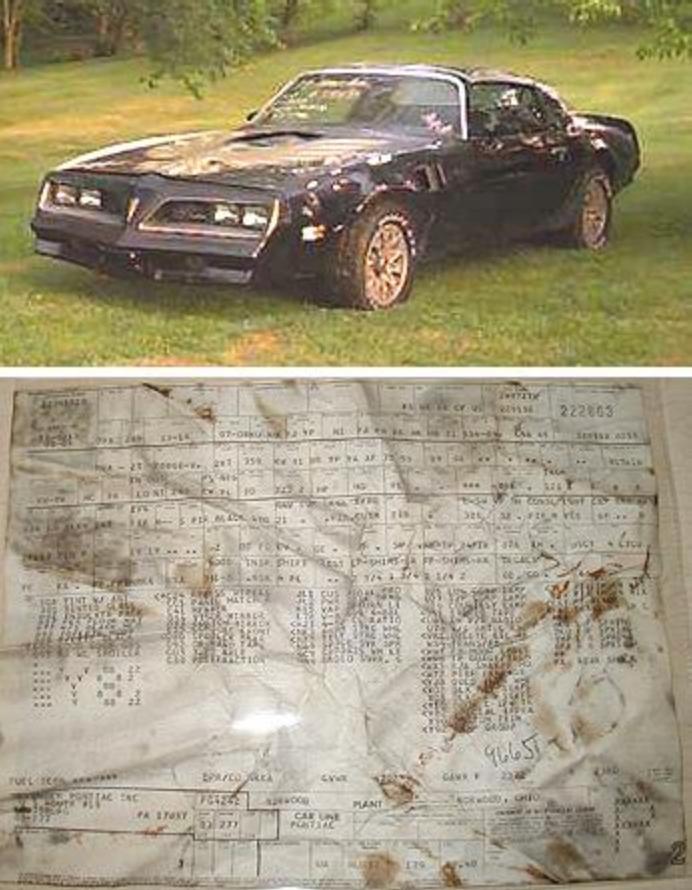 |
|
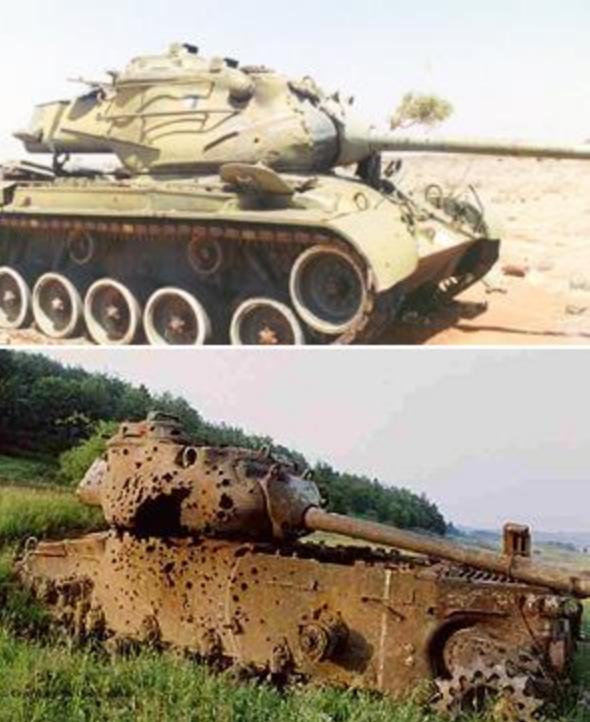 |
|
| |
The "Hog 's Head" boys over in Ohio start in on a new Trans Am
project car. Found in one of the usual places, under the passenger
seat, tucked into the seat springs, the Build Sheet that accompanied
the car from the factory.
--Hog's Head TA |
|
End of the line for a pair of M47s. Top: killed in action in
Eretria, sabot hole in turret just above the bow gunner's hatch.
Bottom: down range in Germany.
--Greville / Cunningham |
|
Geoff Walden, a friend and contributor to
this site, keep all numbers associated with his first tank while
assigned to the 3 AD in the late 1970s. Serial number, USA number,
hull number, he has it all and .... he works for TACOM, if anyone
has the story on his tank, from production to final disposition, it
should only be a few calls and e mails away. No luck. Between the
manufactures and the users, there has never been a great demand for
total tracking, at least for the M60 series. Somewhere along the
line, his M60 A1 has been handed off from user to user, maybe
rebuilt or maybe released to foreign sales. And the current location
... down range in Turkey, off shore near Florida, in front of the
VFW Hall, Main Street Anchorage, Alaska ... who knows?
| |
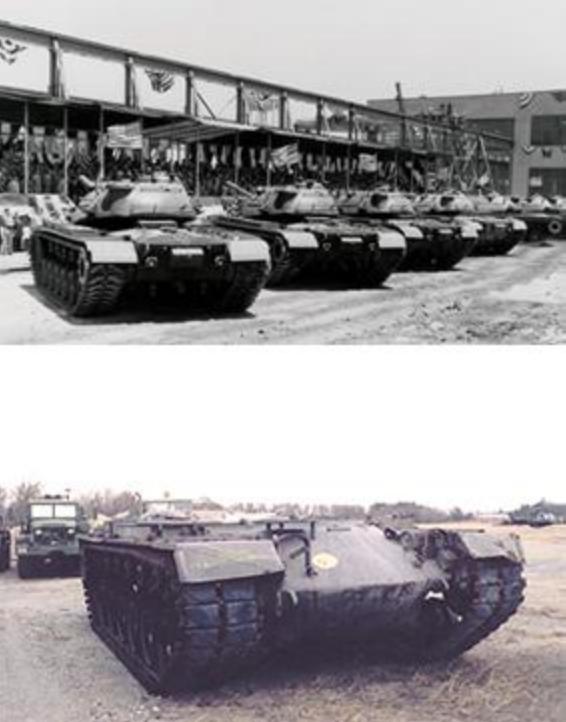 |
|
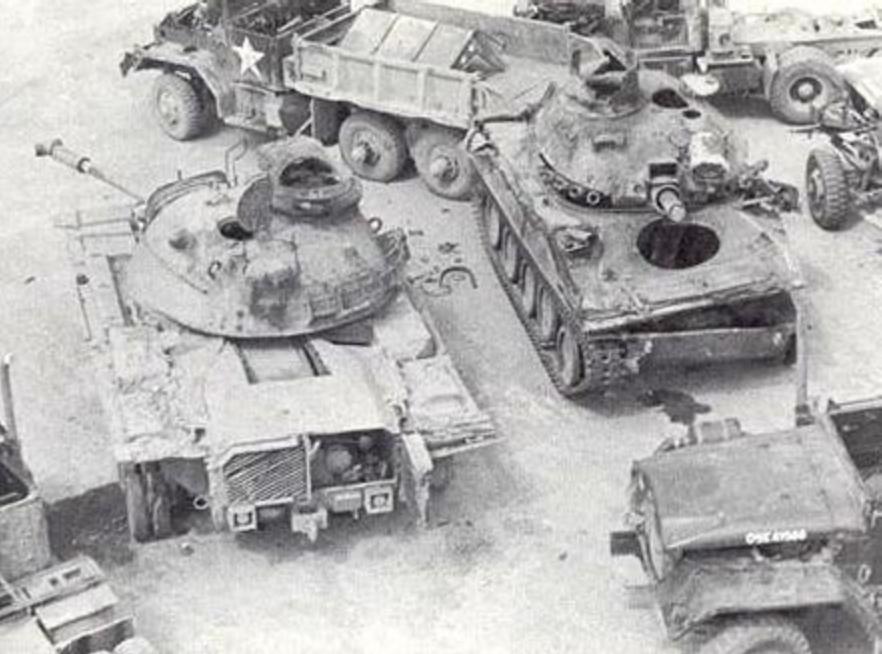 |
|
| |
The Newark Delaware Tank Plant celebrates milestones in M48
assembly. (Delaware Historical Society) A sad survivor that has lost
its turret, now kept on as a project at the Massachusetts National
Guard combined DS / GS Maintenance Center.
--Newark History Center / Stefanowicz |
|
In Vietnam, an M48 and an M551 after heavy mine damage. They are
going home in the hull of a ship.
--US Army |
|
The record keeping of the M1 series is
better, but over at TACOM, they 're not talking. The initial
production run of M1s has returned at least once to the factory for
refurbishment and upgrade. They live on somewhere, maybe with the
reserves. Same with the M3s.
The M113 series can be rebuilt and upgraded
seemingly for eternity. Anniston Army Depot and United Defense of
Arlington, VA split that business. Disassembly and hull repairs are
done in Alabama, upgrades and assembly are done in VA. Thousands
were refurbished and released to foreign sales. But there are some
limits to that program, every fighting vehicle sold by the US
government as a used, Blue Light Special is one less that General
Dynamics or FMC can sell as new. Perhaps if some day, Bolivia and
Bosnia ever square off, a few of the old Eaglehorse APCs will rattle
forward to settle the question. Some from the fleet went to scrap,
others now guard city parks and veteran's memorials. The best bet
for troopers from the Germany period of our squadron is that your
APC may still be out there, running or at least sitting, somewhere.
| |
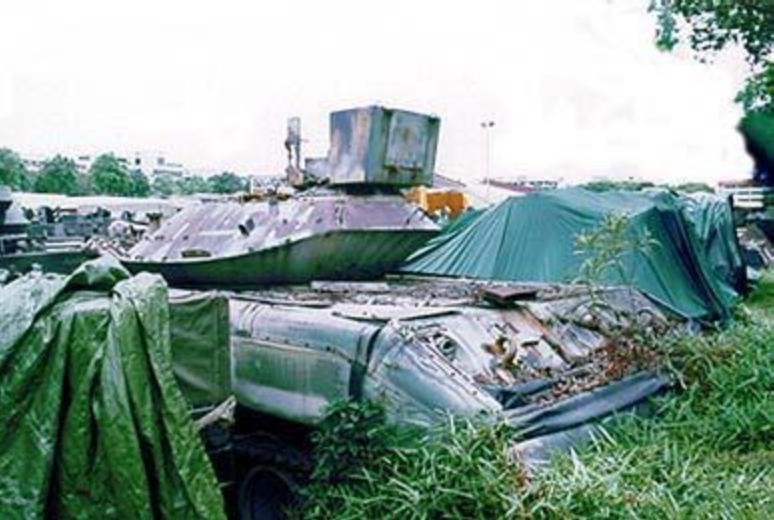 |
|
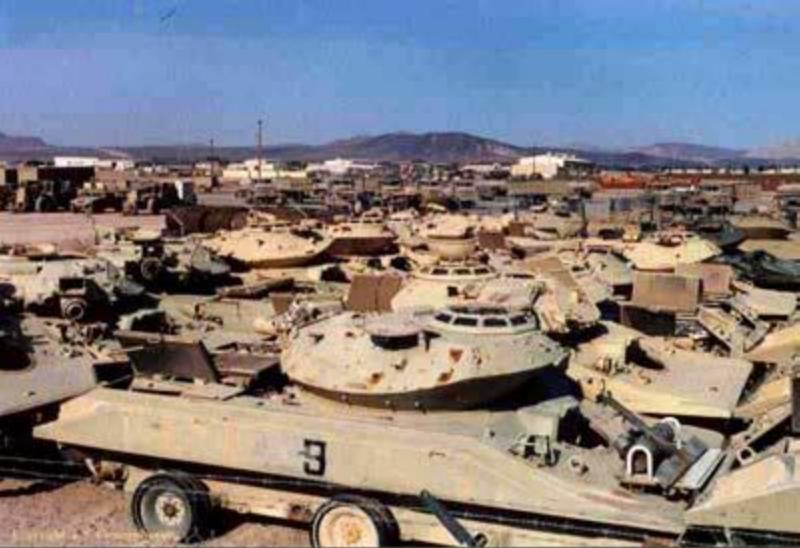 |
|
| |
Sitting in the back of a motor pool, one of the Sheridans that went
into the foreign sales program and ended up in Singapore.
--Gamma |
|
Over 300 Sheridans were allocated to the NTC at the start of OPFOR
program. As repair parts became scarce, non runners were
cannibalized until little beyond the hull remained. Next stop, the
same aluminum smelters that also render obsolete military aircraft
into usable ingots.
--Scott Cunningham |
|
For wheel vehicles, the fate of an
individual is again, impossible to tell but the trend is that with
each specific vehicle species, they worked and they died. At some
point, one by one, the members of the fleet were washed out as non
repairable. Next stop, the PDO yard. When there are too few
survivors and a newer system is coming on line, the funding ends and
that ... is the end of the program. At college in the mid 70s we
would watch train loads of AMC manufactured military trucks and
trailers roll out of town for points unknown. We steered clear of
the union bars but were always amazed by the levels of production of
the union guys.
| |
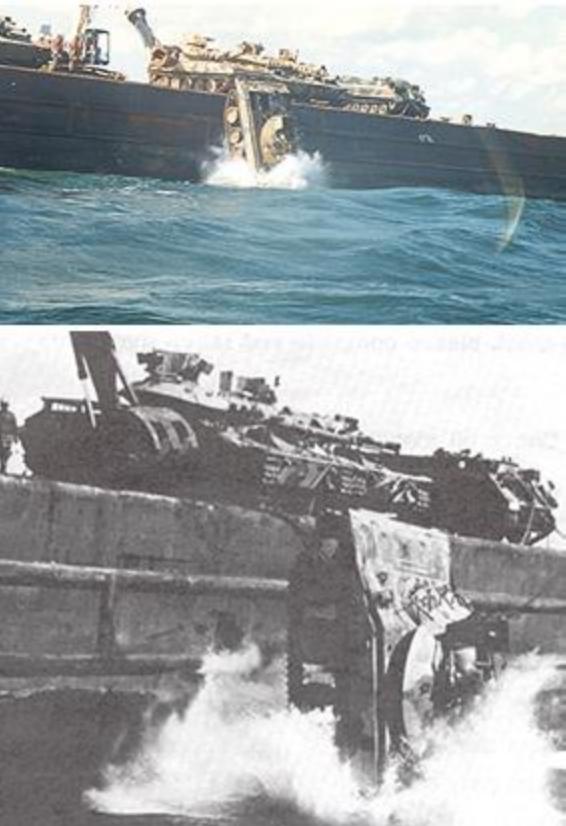 |
|
| |
The last swimming exercise; in the early 1990s, the US Government
and the Bureau of Fisheries and Coastal Management made hundreds of
AFVs available for reef building through the REEFEX Program. The
tanks were thoroughly cleaned, barged to the dump site and pushed
over the side. Also used were old rail passenger cars, small ships
and construction debris. The artificial reefs have a remarkable
positive impact on local fish and shell fish spawning. Here, one of
the 1662 Sheridans built, moves out to its final home. The REEFEX
Program ran from New Jersey to Texas.
--NJ Div Fish, Game and Wildlife |
|
Maybe a very few old wheels survived through
the years and live on as heritage vehicles brought out for parades
or they sit in the barns hoarded by fanciers, "hey ... wanna' see my
Gamma Goat?!". At Daley in 1980, we finally washed out a few of the
old border jeeps. Prior to turn - in, every serviceable part had
been removed and replaced with a defective part; the living would
feed off the dead. As they loaded the "dear departed" to the back of
flat bed trucks with the wrecker boom, in mid air, one jeep folded
in half like a closing wallet.
A few years later at Fort Polk, the
battalion is on the fast tread mill of NTC prep and a part of it is
a Level One tank gunnery. As the S4, I run in front of the lead
company to insure the ammunition and all the rest of the support is
in place as we move through the tables. Polk always offered
surprises and that day was no different. Although the Army was
phasing out the use of "hard targets" on ranges, just too much
trouble in terms of range pollution, management and cost, plus the
whole new generation of smart ranges was just coming on line, in
Louisiana, we had learned to be last in line. A fleet of target
vehicles was waiting their turn for the final act down range.
| |
 |
|
| |
Last round up in Germany. As M1 fielding went forward, these M60A3s
at the Germersheim Depot are collected and wait shipment to the USA.
--Scott Cunningham |
|
Looking at the bumper numbers, it was an odd
lot, former Marine Corps Reserve 2.5 ton trucks from some unit in
Biloxi and an assortment of ultra heavy Army wheeled tractors
apparently just released from depot, freshly oiled and greased. I
wish I had my camera with me, the tractors were model M249s, the
ultra heavy tug for the 280 mm "atomic cannon" of the 1950s. Also in
the group, three Air Force crash and rescue fire trucks from
Barksdale AFB property disposal. Happy the tanker shooting at hot
lime green and hot red targets at 1500 meters. In 1978, part of the
target array at Wildflecken and Grafenwoehr were the much battered
remains of M4 Sherman tanks that had helped win World War II. They
had come a long way from the Detroit Tank Plant to lie shattered in
the mud and the weak sun of Germany in that late Fall.
| |
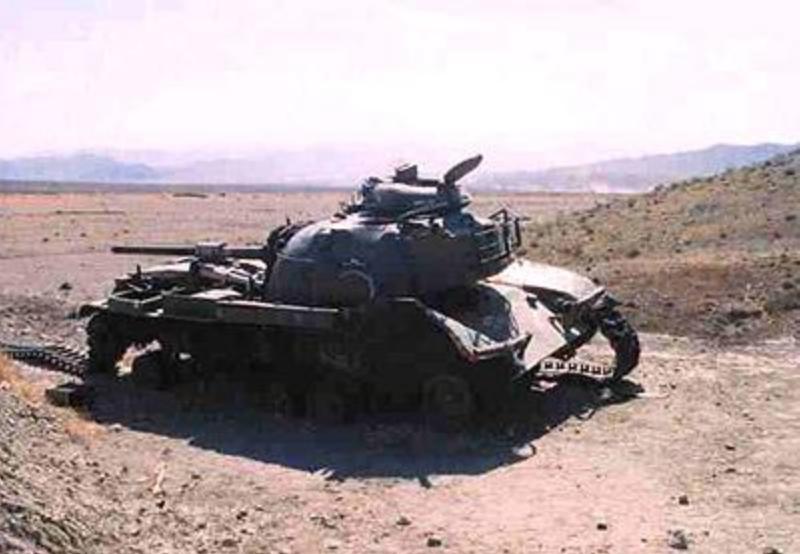 |
|
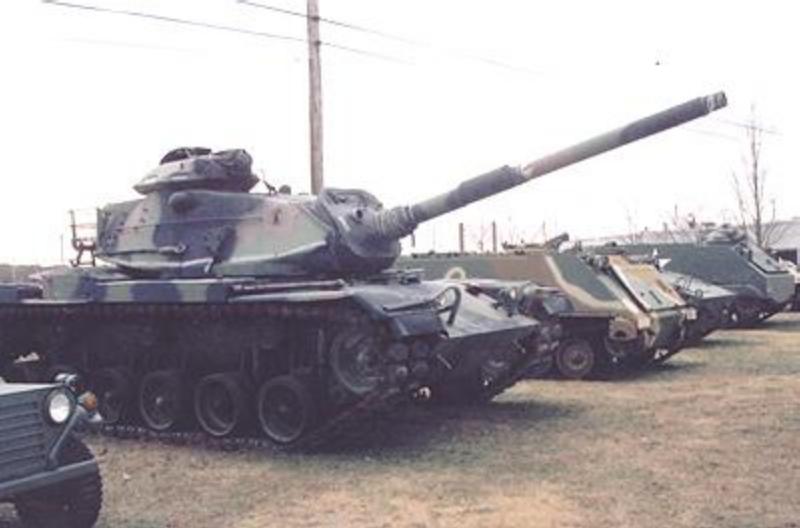 |
|
| |
An M48A5 as a land mark at the NTC.
--Scott Cunningham |
|
A dignified retirement at the Massachusetts National Guard DS / GS
Maintenance Facility.
--Stefanowicz |
|
The vehicles that stand a good chance of
having survived the long years in Germany with the 2/11 and may
still be sitting on an active Army hardstand, may surprise you. All
hail the AVLB, dinosaur survivor through the ages. Division 86 and
following force structure changes called for an ever increasing
number of mobile bridge launchers. Anniston Army Depot, the great
chop shop of the South, ran a conversion program based on M60A3
hulls. The original three carriers of the Eaglehorse may have also
passed through for depot level rebuild.
| |
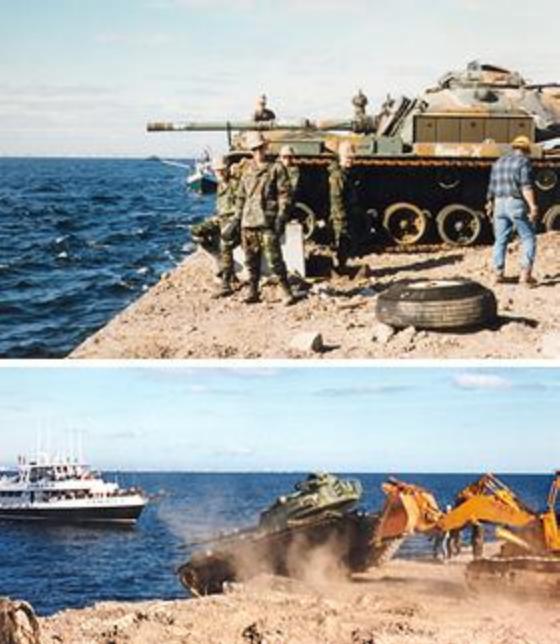 |
|
| |
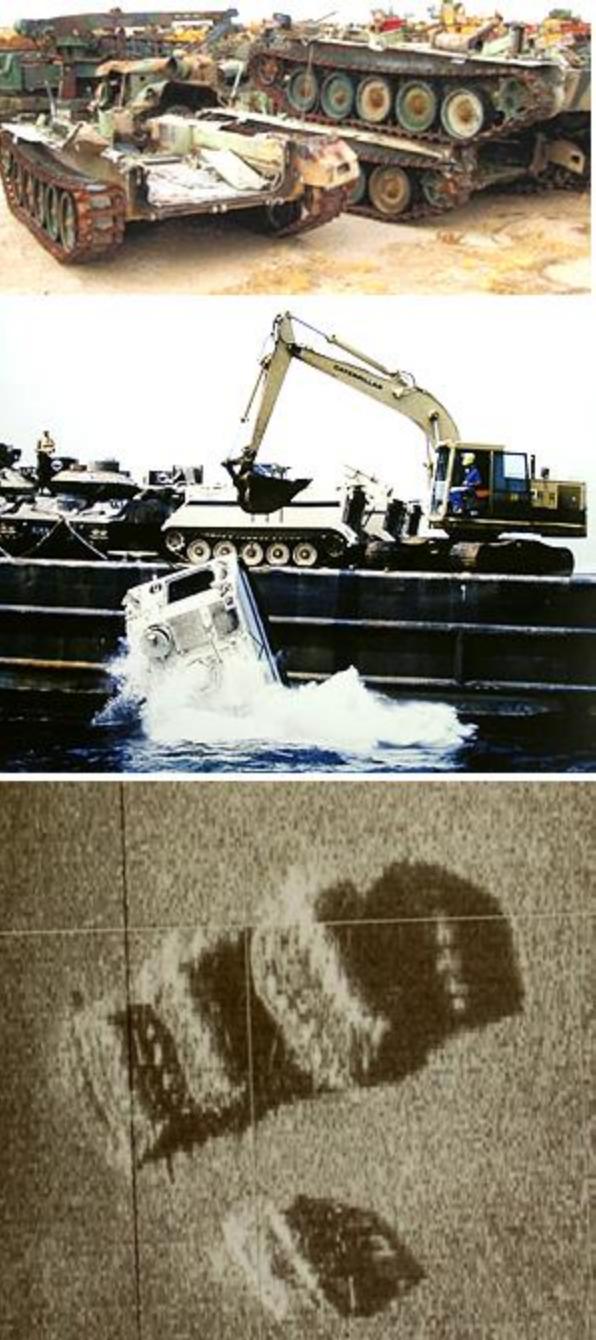 |
|
| |
Over the side in
New Jersey for a platoon of M60A1s.
--NJ Div Fish, Game and Wildliff |
|
Tank trivia: ever wonder where dozens of the
M60A2 hulls ended up when that program ended? All hail the AVLB!
When seen from the rear, a former A2 in use as a bridge carrier
still retains a modified hull, rounded and bulging rear grill doors
and an odd bulge in the rear hull floor, modifications once done to
accommodate the massive compressed air bottle, part of the closed
breech scavenging system for the cannon. As the last of the
Sheridans pass from the Army inventory this year, these lowly A2
based carriers become the answer to tank trivia for a round of beers
at the club, "... what are the oldest track vehicles in active
inventory?" The Wolverine bridge carrier program, based on the
M1 platform appears dead. All hail the M60 hull AVLB, survivor
through the ages. These carriers may out last us all.
| |
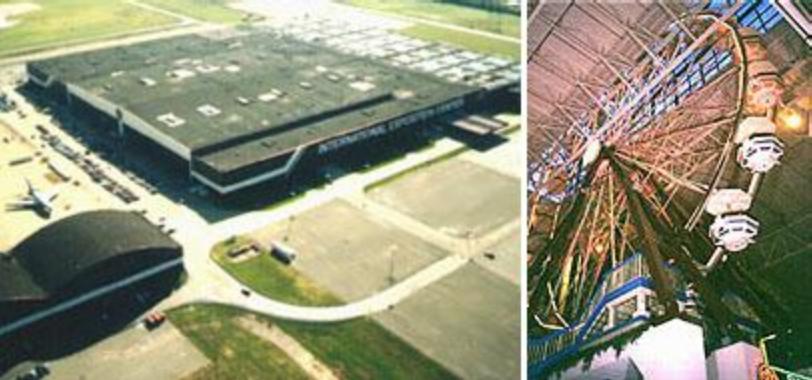 |
|
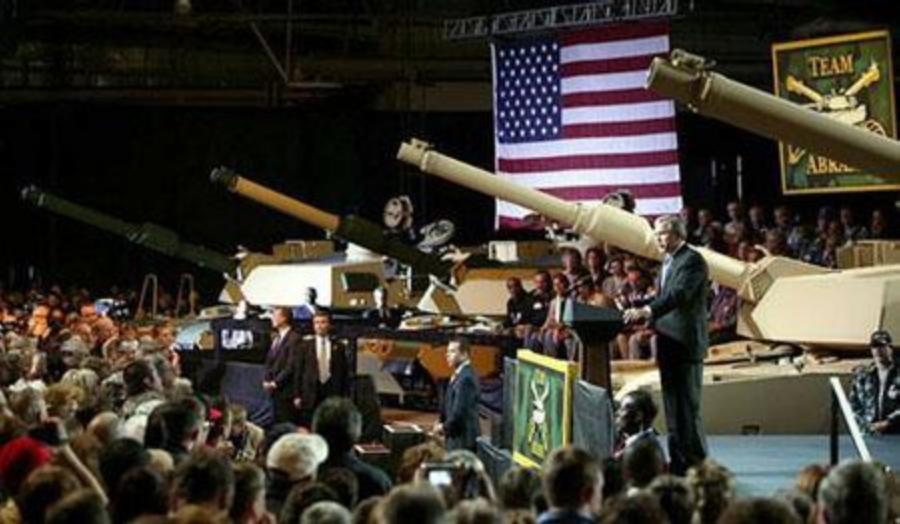 |
|
| |
Cleveland Exposition Center, once the GM - Cadillac Tank Plant. From
M551 Sheridan and the M109 cannon fleets to the world's largest
indoor Ferris Wheel. Let's go to the car show!!
--Gamma |
|
He spoke, they clapped, he left. President Bush at the Lima Tank
Plant.
--White House Press Site |
|
If we are asking where they went, we should
also consider where they came from. The tank manufacturing base has
significantly changed. Delaware Tank Plant, long out of the defense
industry is back to producing mini vans for Chrysler. They played a
large role in the early years of tank production and built their
share of M48s and M60s. We believe they may have had a role in the
M60A2 final assembly as well.
The Detroit Tank Plant, once the Willow Run
for US armored fighting vehicles, dates back to WWII and once set
production level records for tanks produced per hour!! The massive
complex in Warren, just north of Detroit is still the home for the TACOM campus; the vast majority of the production space that started
with M4 Shermans and ended with M1s is in the process of private
sector colonization. The plant was run by Chrysler under various
partnerships with the Army, then operations were sold to General
Dynamics. Chances are very good that your M48 - M60 was built here.
Big news ... a firm to produce seats for the Ford F150 pick up has
procured space at the former plant and will soon get production
under way. The fate of the rest of the complex is confusing. One
real estate news letter brags all available space now leased,
another source quotes 1 million square feet still vacant. That’s the
way things are in Detroit, wild claims everywhere and the truth out
there somewhere.
| |
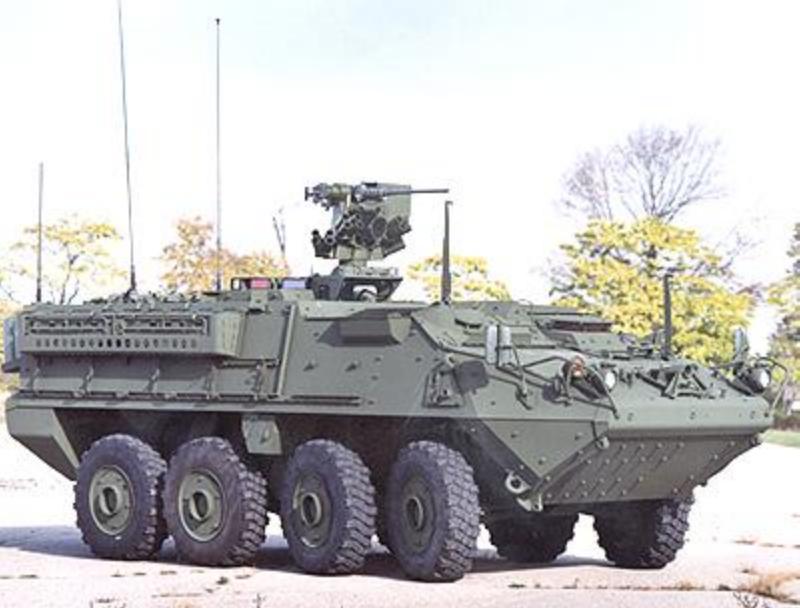 |
|
| |
Welcome to the future ... the Stryker platform on which over eight
variants will be produced for the US Army at London Ontario.
--US Army |
|
Heading southeast to Cleveland, the next
tank plant, tucked adjacent to the airport (and if you ever flew
into Cleveland, you saw it, the flight path offered a great view)
has been thoroughly re - worked into a convention and exposition
site. This is where the Cadillac division of GM ran their tank
plant, among the many vehicles that came through, the M41 and the
M109 cannon. They built every M551 Sheridan. Retired assembly line
guys probably sit around and recall good manufacturing jobs with
great wages ... the exposition space now boasts the world's largest
indoor Ferris Wheel, one million square feet of empty space with
full convention amenities. Let's have a Strohs, let's go to the car
show!
| |
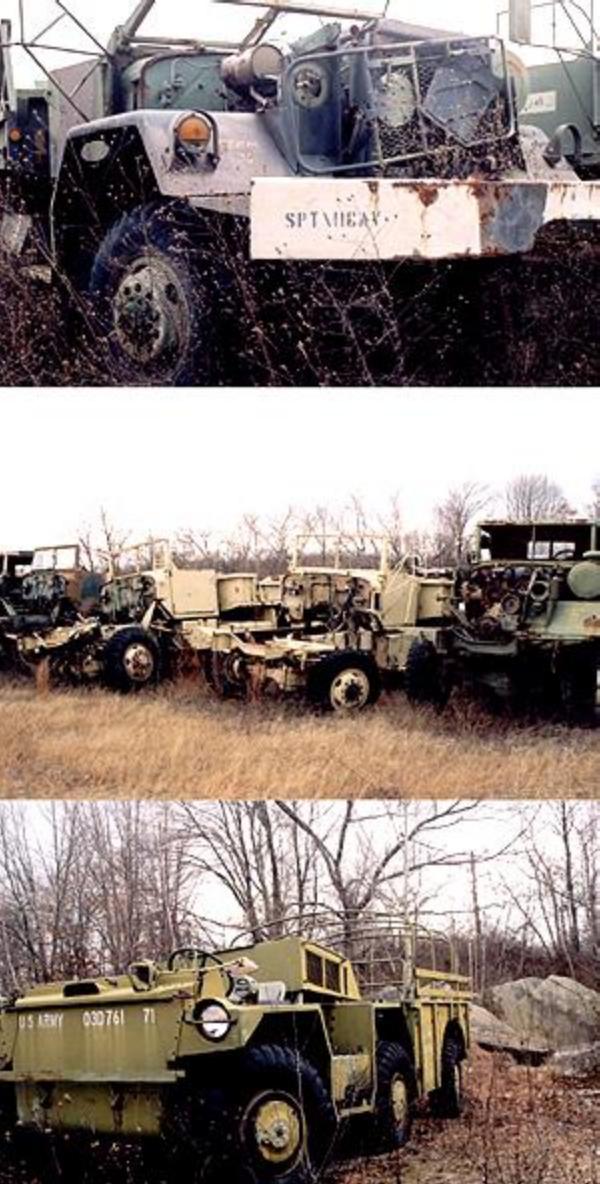 |
|
| |
Ridden hard and out to pasture, part of the scrap line at the MA NG
DS / GS facility. For the vehicle in top image, it is a long ...
long way from Kuwait to the NTC to Ayer Massachusetts. Once a
sufficiently large pool of scrap vehicles has been created, the lot
is auctioned off.
--Stefanowicz
More Out to Pasture . . .
|
|
Next stop, Lima Ohio. The Soviet defense
industry once removed entire cities from their maps in the interest
of security. We note that Lima appears to be disappearing from many
maps as well. No one will discuss the plant and there are no photos
available. It is a GOCO, government owned - contractor operated
defense plant, General Dynamics Land Warfare Systems is the lead
contractor. This plant also dates back to WWII but now, thoroughly
modernized, it is the center for M1 upgrade and reassembly.
Everything comes in wrapped in tarps or on covered rail cars and
goes out the same way. When President Bush staged a recent photo
opportunity in the Mid West that required tanks and flags, it was
held there. Surrounded by union workers (( only recently back from a
job action )) he spoke, they clapped, he left.
| |
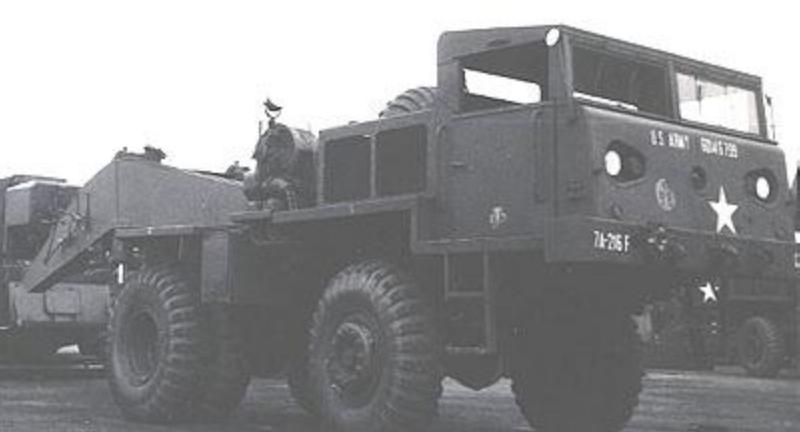 |
|
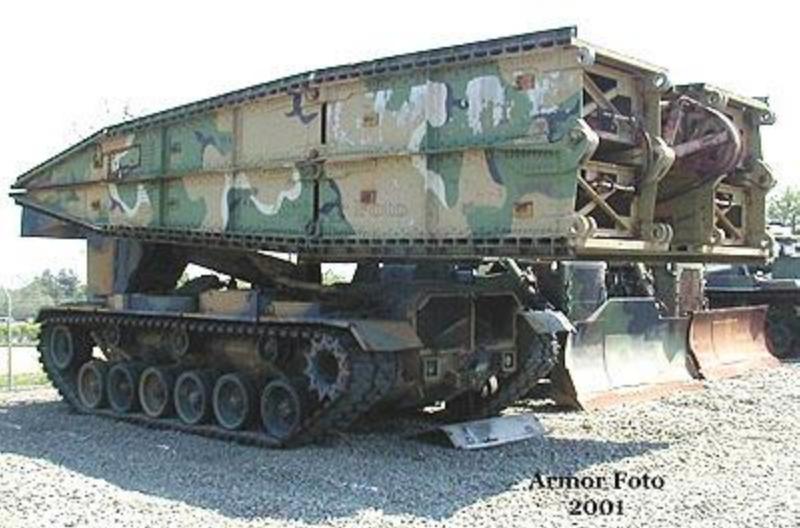 |
|
| |
File image of the M249 Heavy Tractor, part of the tandem set used to
move the Atomic Cannons around Germany and the USA. With batteries
and a few hours of start up maintenance, the ones I found at the
Polk range lot could have been driven away.
--Gamma |
|
They will out last all of us.
--Doug Greville |
|
The M1A2 SEP upgrade program for the main
battle tank in the US fleet is one of the significant activities at
the Lima Ohio tank plant although they have cut the work force by
3/4s. As with the M113s, the tanks are disassembled at Annsiton and
then upgraded and reassembled in Ohio. I understand a couple are
finished each week. This rebuild and upgrade brings portions of the
M1 fleet to the highest state of modern armor technology.
In Iraq, M1s and M2s programmed to last six
years before recall to depot will hit that key mileage milestone
after about one year of deployment. Looks like good job stability at
Lima for some time to come.
We note that in Canada, they have decided to
not continue the turret and fire control upgrade program for their
aging fleet of Leo 1s but will step away from tanks in favor of the
Styrker system. The Canadian tanks will be mothballed but up in
London Ontario, no one is crying. Its good jobs at good wages paid
in Canadian dollars. At the big plant, the flat bed trucks and rail
cars arrive just in time each work day. We exported the jobs and now
we export the sub assemblies. The significant new contract at Lima
involves fabrication of portions of the Stryker crew compartment as
the Army embraces the faster - lighter wheeled combat vehicle. The
component parts are built, boxed and shipped ... to Canada for final
assembly. Perhaps someone looks after the build sheets.
| |
 |
|
| |
Two views of the Detroit Tank Plant in Warren Michigan. The factory
complex stretches on for acres in all directions. Next product,
truck seats for Ford.
--Gamma |
|
|
|